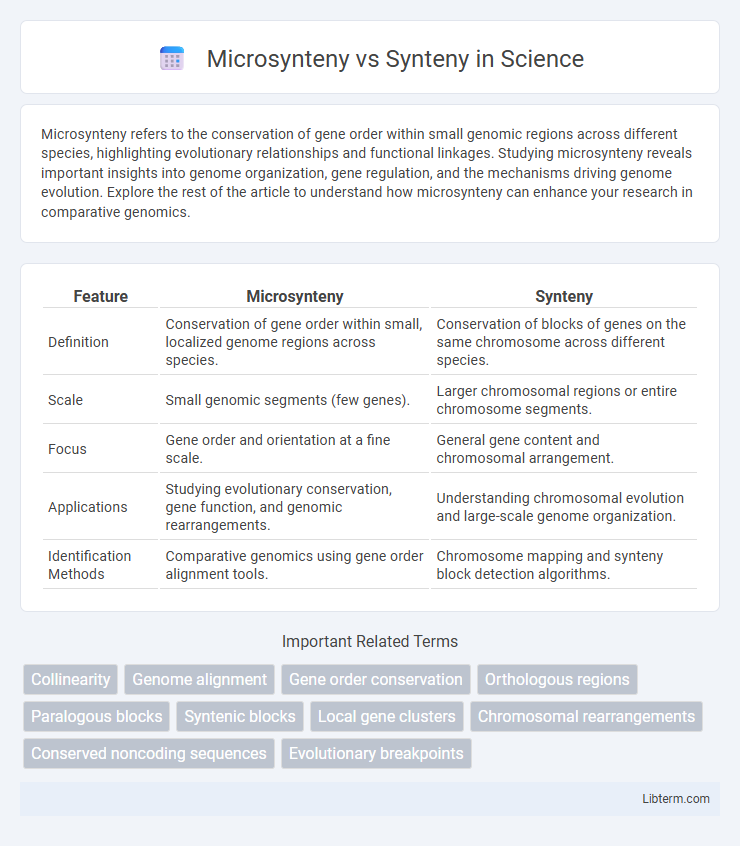Microsynteny refers to the conservation of gene order within small genomic regions across different species, highlighting evolutionary relationships and functional linkages. Studying microsynteny reveals important insights into genome organization, gene regulation, and the mechanisms driving genome evolution. Explore the rest of the article to understand how microsynteny can enhance your research in comparative genomics.
Table of Comparison
| Feature | Microsynteny | Synteny |
|---|---|---|
| Definition | Conservation of gene order within small, localized genome regions across species. | Conservation of blocks of genes on the same chromosome across different species. |
| Scale | Small genomic segments (few genes). | Larger chromosomal regions or entire chromosome segments. |
| Focus | Gene order and orientation at a fine scale. | General gene content and chromosomal arrangement. |
| Applications | Studying evolutionary conservation, gene function, and genomic rearrangements. | Understanding chromosomal evolution and large-scale genome organization. |
| Identification Methods | Comparative genomics using gene order alignment tools. | Chromosome mapping and synteny block detection algorithms. |
Introduction to Synteny and Microsynteny
Synteny refers to the conservation of blocks of genes or genetic markers on the same chromosome across different species, highlighting evolutionary relationships and genome organization. Microsynteny focuses on the preservation of gene order and orientation within smaller genomic regions, often involving a few genes or short DNA segments. Both concepts are fundamental in comparative genomics for understanding genome evolution, functional annotation, and identifying orthologous genes.
Definitions: Synteny vs Microsynteny
Synteny refers to the conservation of blocks of genes on chromosomes across different species, indicating shared ancestry and genomic organization. Microsynteny describes the retention of gene order and orientation within smaller genomic regions or gene clusters, providing finer resolution of evolutionary relationships. Both concepts are crucial for comparative genomics but differ in scale, with synteny addressing larger chromosomal segments and microsynteny focusing on localized gene arrangements.
Historical Context of Synteny Studies
Synteny studies trace their origin back to early genetic research in the 20th century, where scientists identified conserved blocks of genes on chromosomes across different species. Microsynteny, a more refined concept, emerged with advances in molecular genetics and comparative genomics, highlighting the preservation of gene order and orientation at a finer scale. The historical evolution of synteny research has been instrumental in understanding chromosomal rearrangements and evolutionary relationships among organisms.
Key Differences between Synteny and Microsynteny
Synteny refers to the conservation of blocks of genes on chromosomes across different species, indicating large-scale chromosomal similarity, while microsynteny focuses on the preservation of gene order and orientation within smaller genomic regions. Key differences lie in their scale and resolution; synteny examines broad chromosomal segments typically spanning millions of base pairs, whereas microsynteny delves into finer details, often just a few genes or kilobases in size. Microsynteny provides higher precision in evolutionary and functional genomics studies by revealing local gene arrangement conservation, which can be obscured in broader syntenic analyses.
Methods for Analyzing Synteny and Microsynteny
Methods for analyzing synteny typically involve comparative genomics tools like MCScanX and SynMap, which detect conserved gene order across large chromosomal regions. Microsynteny analysis requires higher-resolution approaches such as pairwise gene collinearity and dot-plot visualization to focus on small blocks of conserved gene clusters at the local level. Both analyses rely heavily on sequence alignment algorithms and gene annotation databases to accurately identify orthologous gene pairs and evolutionary rearrangements.
Biological Significance of Synteny Comparisons
Microsynteny refers to the conservation of small chromosome segments, often involving a few genes, whereas synteny encompasses larger chromosomal regions conserved across species. Comparing syntenic blocks reveals evolutionary relationships, gene order conservation, and genome rearrangements, which are crucial for understanding functional gene clusters and regulatory mechanisms. These insights facilitate the identification of orthologous genes and contribute to genome annotation, comparative genomics, and evolutionary biology studies.
Microsynteny in Evolutionary Genomics
Microsynteny refers to the conservation of gene order and orientation within small genomic regions across different species, providing insights into structural genome evolution and functional gene clustering. In evolutionary genomics, microsynteny is crucial for identifying homologous genes and tracing lineage-specific rearrangements that may be obscured at broader scales of synteny. This fine-scale genomic conservation aids in understanding gene regulation evolution, chromosomal rearrangements, and the mechanisms driving genome organization diversification.
Applications in Comparative Genomics
Microsynteny refers to the conservation of small genomic regions with limited gene numbers and order, while synteny involves larger chromosomal segments showing gene collinearity across species. Comparative genomics applications leverage microsynteny to identify functional elements and regulatory sequences by analyzing gene clusters in closely related species, aiding in evolutionary studies and gene annotation. Synteny maps facilitate the detection of large-scale chromosomal rearrangements, genome evolution patterns, and orthologous gene relationships across distant taxa.
Challenges and Limitations in Synteny Analysis
Synteny analysis faces challenges such as the difficulty in accurately identifying conserved gene order across divergent species due to genome rearrangements, gene duplications, and varying evolutionary distances. Microsynteny, focusing on smaller genomic regions with conserved gene order, mitigates some limitations of broader synteny analysis by reducing noise from large-scale rearrangements but still struggles with incomplete genome annotations and paralogous gene assignments. Both synteny and microsynteny analyses are constrained by the quality of reference genomes and the complexity of distinguishing orthologous genes from paralogs, impacting the reliability of evolutionary and functional inferences.
Future Perspectives in Synteny and Microsynteny Research
Microsynteny and synteny research continues to unveil intricate details of genome organization, with future perspectives pointing toward leveraging high-resolution sequencing and advanced computational tools to map gene order conservation at increasingly fine scales. Emerging technologies, including single-cell genomics and chromosome conformation capture, promise to clarify the dynamic evolutionary processes shaping microsynteny patterns across diverse species. Integrating multi-omic datasets and machine learning approaches will enhance predictive models for genome evolution, gene regulation, and functional annotation, driving breakthroughs in comparative genomics and evolutionary biology.
Microsynteny Infographic

 libterm.com
libterm.com